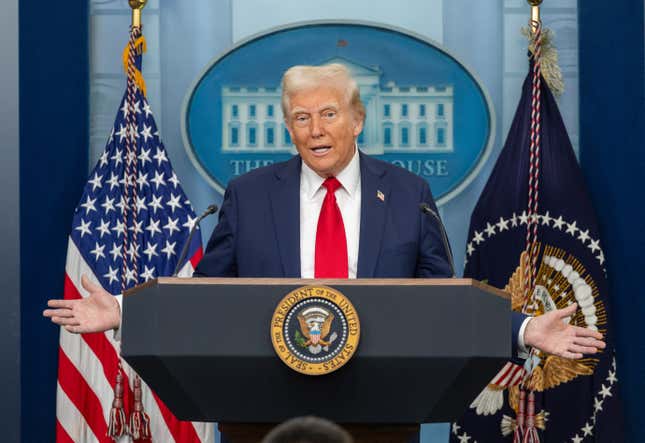
In This Story
President Donald Trump on Saturday officially announced new tariffs on imports from the United States’ top trade partners, paving the way for retaliation and a new trade war.
Trump said on his social media site Truth Social that he had implemented tariffs of 25% on imports from Canada and Mexico, with lower 10% tariffs on Canadian oil. He said he was also implementing 10% tariffs on imports from China.
“This was done through the International Emergency Economic Powers Act (IEEPA) because of the major threat of illegal aliens and deadly drugs killing our Citizens, including fentanyl,” Trump said. “We need to protect Americans, and it is my duty as President to ensure the safety of all. I made a promise on my Campaign to stop the flood of illegal aliens and drugs from pouring across our Borders, and Americans overwhelmingly voted in favor of it.
Trump, who has made the threat of tariffs a cornerstone of his economic policy, first threatened the counties with big tariffs months ago, citing the flow of illegal drugs such as fentanyl and undocumented immigrants into the U.S. He has repeated those threats several times in recent weeks, along with the trade deficit between the U.S. and those countries, which he labeled a “massive” subsidy.
According to the non-partisan Tax Foundation, Trump’s proposed tariffs on Mexico, Canada, and China are projected to shrink economic output by 0.4% and increase taxes by $1.2 trillion between 2025 and 2034. That comes out to an average tax increase of more than $830 per household this year.
Between January and November 2024, trade with Canada came out to $699 billion and $776 billion with Mexico, according to the U.S. Census Bureau. The U.S. imports $157.2 billion more worth of goods from Mexico than it exports, while its trade deficit with Canada is about $55 billion. China was the U.S.’s third-biggest trade partner last year, with overall trade as of November totaling more than $532 billion and a trade deficit of $270 billion.
Read more: All the ways Trump has threatened tariffs, from Canada to Russia
Automakers will be particularly vulnerable. According to S&P Global Mobility (SPGI+0.75%), almost all original equipment manufacturers will be impacted by the tariffs on Canada and Mexico.
Some 3.6 million light vehicles were imported from the two countries in 2024, accounting for 22% of all vehicles sold in the U.S. Wolfe Research has estimated a 25% tariff would add about $3,000 to the average cost of vehicles sold in the U.S.
Volkswagen (VWAGY-2.90%) is most vulnerable, with 43% of its U.S. sales sourced from Mexico. It’s followed by Nissan (NSANY-0.83%) (27%), Stellantis (STLA-3.60%) (23%), General Motors (GM-4.40%) (22%), Ford Motor Co. (F-2.22%) (just shy of 15%), Honda Motor Co. (HMC-1.02%) (13%), and Toyota Motor Co. (TM-2.30%) and Hyundai Motor Co. (HYMTF-1.90%), which each source 8% of their U.S. sales from Mexico, according to S&P Global Mobility. Several companies, including GM and Ford, also source vehicles from Canada.
“With respect to possible tariffs, we are working across our supply chain, logistics network, and assembly plants so that we are prepared to mitigate near-term impacts,” GM CEO Mary Barra said this week.
“The imposition of tariffs, which is very likely, will have an impact on our business and profitability,” Tesla (TSLA-3.33%) CFO Vaibhav Taneja told investors on Wednesday’s earnings call, noting that the company is “very reliant” on parts from across the world. Tesla CEO Elon Musk said last year the company would pause its work on a Mexico factory over Trump’s tariffs.
Tariffs on oil could also become a problem.
Canada shipped more than four million barrels of crude oil to the U.S. each day over the first 11 months of 2024, while Mexico delivered 465,000 per day, making them the biggest crude oil exporters to the U.S. by far. Timothy Fitzgerald, a professor of business economics at the University of Tennessee, told ABC News that could raise gas prices by as much as 70 cents per gallon across the U.S.
Other major imports from Canada, Mexico, and China include fruit and vegetables, aluminum, wood, plastics, electronics, semiconductors, and other goods. The U.S. imported $38.5 billion in agricultural goods from Mexico in 2023, including 90% of all avocados, along with $40.5 billion worth of agricultural imports from Canada.
Each of the impacted nations is readying their response, although exact details are still unclear.
“No one — on either side of the border — wants to see American tariffs on Canadian goods,” Canadian Prime Minister Justin Trudeau said in a statement Friday. “We’re working hard to prevent these tariffs, but if the United States moves ahead, Canada’s ready with a forceful and immediate response.”
Mexico President Claudia Sheinbaum on Wednesday said she didn’t believe the U.S. would impose tariffs, but that her administration has a response ready. Mao Ning, a spokesperson for China’s foreign ministry, said last week that “trade wars and tariff wars have no winners, do not serve the interests of any party, and are not beneficial to the world.”
Mexico’s tariffs would likely target food products, such as cheese, pork, and whiskey, along with manufactured steel and aluminum, Reuters reports. Canada would target some $25.6 billion worth of goods, including food and beverages, dishwashers, and toilets, the New York Times reported.